Seagate Backup Plus Portable 5TB & Backup Plus Slim 2TB Review: SMR for the Consumer Market
by Ganesh T S on June 18, 2019 8:00 AM ESTInvestigating SMR for Consumer Workloads
The nature of the platters in a hard drive (CMR or SMR), unless explicitly mentioned, is not immediately evident from the specifications or even artificial benchmark tests that use a small work set. Even replaying real-world work traces often only provides slight hints about the presence of SMR. Our first tryst with SMR in the lab was the 8TB Seagate Archive HDD, followed by the retail-focused Seagate Innov8. While the Archive HDD (one of the first SMR drives from Seagate that went into mass production) had dismal performance consistency, the Innov8 carried substantially improved firmware that enabled much better overall performance numbers. With the passage of time, Seagate has improved the firmware to such an extent that the tests detailed in the link above can no longer reliably detect the presence of SMR in a drive.
Detecting SMR - The Sequential Writes Test
One of the tests we have recently started doing on flash-based storage devices is performance consistency under extremely stressful sequential write workloads. The fio workload used for this purpose was adapted for running on the external hard drives. This 128K sequential write workload was set to span the entire capacity of the drive. First off, we take a look at the processing of this workload on a CMR drive - the WD My Passport 4TB.
We see the bandwidth numbers between 90 MBps and 110 MBps as we start off at the outer edge of the platters. We see a gradual steady drop down to 50-70 MBps as we move towards the center. This drop (based on the sector location in the drive's platters) is a well-known phenomenon due to the presence of a larger number of sectors on a per-revolution basis as we move further away from the center of the platter.
The Seagate Backup Plus Slim, on the other hand, starts off between 125 and 135 MBps and ends up between 60 and 80 MBps. Worryingly, we have drops down to 10 MBps frequently. It can be seen that the firmware tries to avoid these slow write scenarios as much as possible (almost a hour of sustained sequential writes), but, the amount of traditional PMR space in the platters eventually runs out and the drive is forced to record to the shingled space. This results in the drop of the instantaneous write rates to 10 MBps periodically.
The same behavior is seen in the Seagate Backup Plus Portable 5TB drive also.
The 5TB drive is actually able to avoid writing to the SMR space for more than 90 minutes before yielding to the inevitable.
Backing up System Images - A Real World Test
Sustained sequential writes for a hour or more are not realistic workloads for a majority of the retail consumers. However, it must be noted that the drop in transfer rates may start to happen after all the non-shingled areas are already filled with data. Thus, once the SMR drive is, say 20 - 25% full, it is likely that users will see considerably worse performance compared to a fresh drive. To test this, we brought back the LaCie Porsche Design Mobile 4TB (also a SMR drive) and filled it to around 14% of the capacity with system images of different PCs created using the System Image Backup native utility in Windows. The same data was also used to put the other hard drives in the 'used' state.
A system image of the testbed was then taken on the extrnal drive, while the read and write transfer rates to the drive were monitored.
The WD My Passport 4TB shows the system image write out being consistently between 70 MBps and 110 MBps. In contrast, the Porsche Design Mobile drive (of the same capacity) had frequent dips to around 20 MBps. The peaks were higher at 130 MBps. Despite the higher peaks, the LaCie Porsche Design Mobile took more time compared to the WD My Passport for recording the system image.
Graphs for the same scenario involving the Backup Plus Slim and Backup Plus portable show that the SMR issue is still exposed. However, the valleys are spread much farther apart compared to the LaCie Porsche Design Mobile from a couple of years back.
SMR drives do show higher peak performance numbers compared to CMR drives with the same capacity. However, the lack of performance consistency means that a CMR drive is a more predicable medium for typical consumer workloads in the long run.


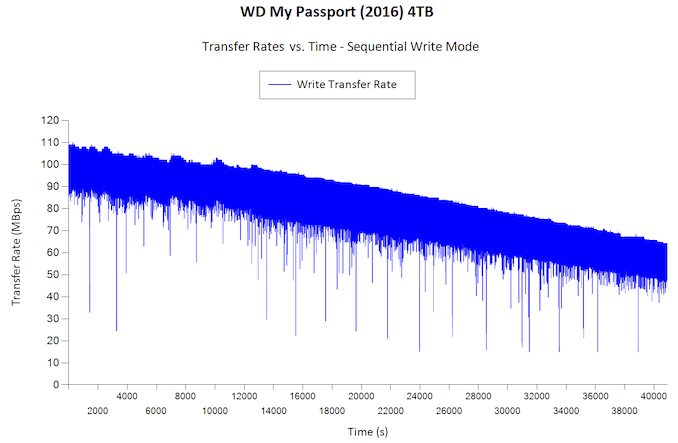


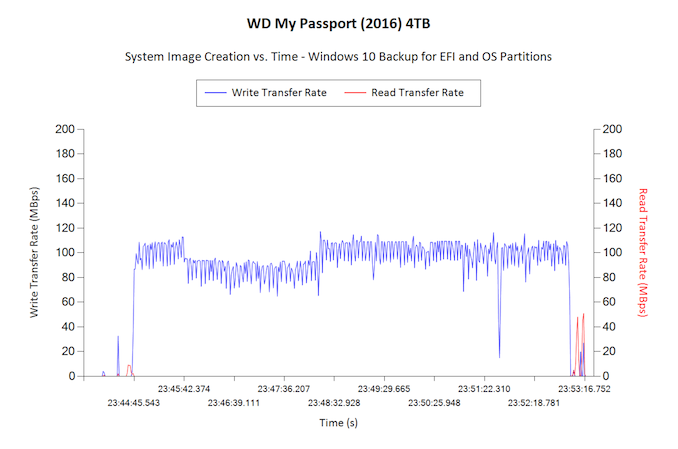
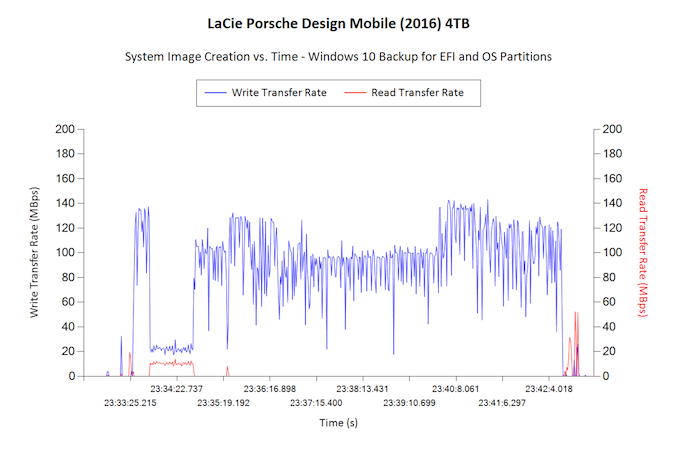
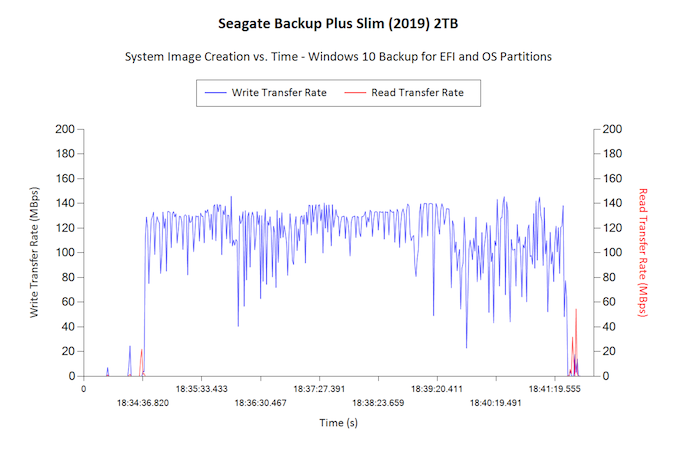
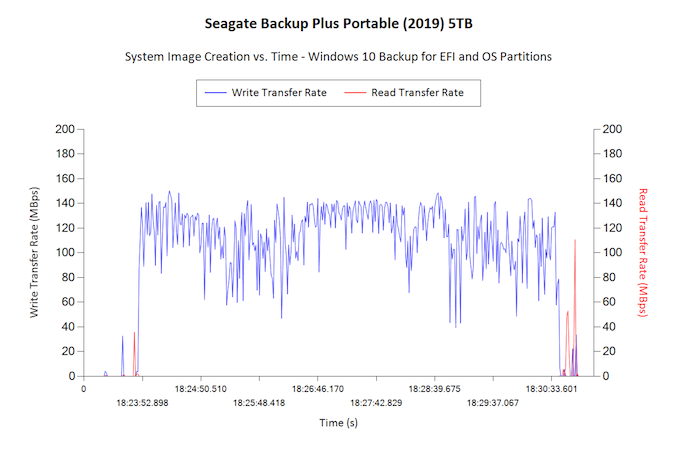








62 Comments
View All Comments
Oliseo - Sunday, June 23, 2019 - link
If swapping a cable solves your issue, then it's the cable and not the connector. Otherwise a new cable wouldn't resolve the problem.My money would be that your bending the cables too much, and this stress is fracturing the core.
abufrejoval - Wednesday, June 19, 2019 - link
I find it hard to trust any drive with really valuable data. And it gets worse as capacity increases.So when I had to upgrade and expand a RAID6 of 8x2TB 3.5" drives I could have gone with fewer drives at higher capacity, but RAID6 becomes really unattracive at lower disk counts, RAID1 wasn't really ideal without a hot spare and sticking with older low capacity drives didn't seem really attractive either.
So I took a chance and switched to 2.5", which had the exact same €/TB cost as 3.5" drives, but retained a high spindle count for throughput at much lower power and I was glad the old 2.5" price premium is finally gone.
Only Segate had them at 4TB and with RAID support, which gave me the extra capacity at a tolerable price. Not sure I'd want to suffer a RAID6 rebuild on 8x 14TB drives: It already takes three days at 4TB.
I used to operate another RAID with WD notebook HDDs, but without TLER I had too many unnecessary rebuilds and abandoned "extra low power RAID" for a while.
I'd have taken a WD, because they are my favorite brand for the last decade, but they don't offer a product in that "above notebook" NAS range below SAS drives. So I deliberated, compared technical data sheets, researched Seagates recent quality history a bit and risked a dive.
Six months 24x7 no issues so far, confidence is rising. The backup system runs a mix of WD-Green and Red but also Seagate "video surveillance" drives (all 3.5") since at least 5 years, again, no issues, but not 24x7.
I don't think there are significant constant quality defects in any surviving HDD manufacturer, when it comes to a conservative middle spot of the drives themselves. At the very leading capacity or technology edge, they sell to the hyperscalers on unforgiving contracts so by the time the product reaches mass market, they know what they do and what they cannot afford.
They might cut corners in an external chassis, customers might also forget these chassis contain delicate mechanics that are susceptible to heat, humidity and power variations, but the core hard drive is a known quantity.
Which is why these drives should never contain the only copy of anything you consider valuable.
abufrejoval - Wednesday, June 19, 2019 - link
Just to be clear: Those 4TB drives in the RAID6 are absolutely not SMR...azfacea - Tuesday, June 18, 2019 - link
Imagine buying hard drive in 2k19 LULneblogai - Tuesday, June 18, 2019 - link
I can easilly imagine doing that, if my 4.5 year old 3TB Toshiba died. The issue is, buying a 3TB now would not be cheaper, than it was then.neblogai - Tuesday, June 18, 2019 - link
Edit: 5.5year old.nandnandnand - Tuesday, June 18, 2019 - link
How much was your 3 TB when you bought it? What kind (internal, external, portable)?neblogai - Tuesday, June 18, 2019 - link
It is internal, 81.6 British pounds, bought in Jan 2014 on Ebuyer. Yes, I know it can be found a little bit cheaper now- but, you know, 13 pounds cheaper after 5.5 years, in tech? Inflation alone was 11% 2014-2019.quiksilvr - Tuesday, June 18, 2019 - link
Cost of steel, import taxes, etc. are all huge factors. The big reason why HDD prices are still what they are at these capacities is because there is no cheap alternatives (yet) at these capacities and there is only so much optimization you can do. SSDs have basically toppled the HDD market in anything less than 1TB but they still cost over 2x as much in the 1TB realm and 3-4 times in 2TB because the difference in 1TB and 2TB in the HDD space is from $50 to $60, not $100 to $200 like an SSD.imaheadcase - Tuesday, June 18, 2019 - link
People still do use them for home servers for Media. Its not practical to stream or upload all type of content available. Esp if have shoddy internet access. While SSD drives are getting better in size and reliability...the price is not anything close yet to mass storage for all media types.Its not uncommon for people to have regular hardrives for 5-10 years of operation in a server for just homes. I think my oldest is from 2014 and still going strong.